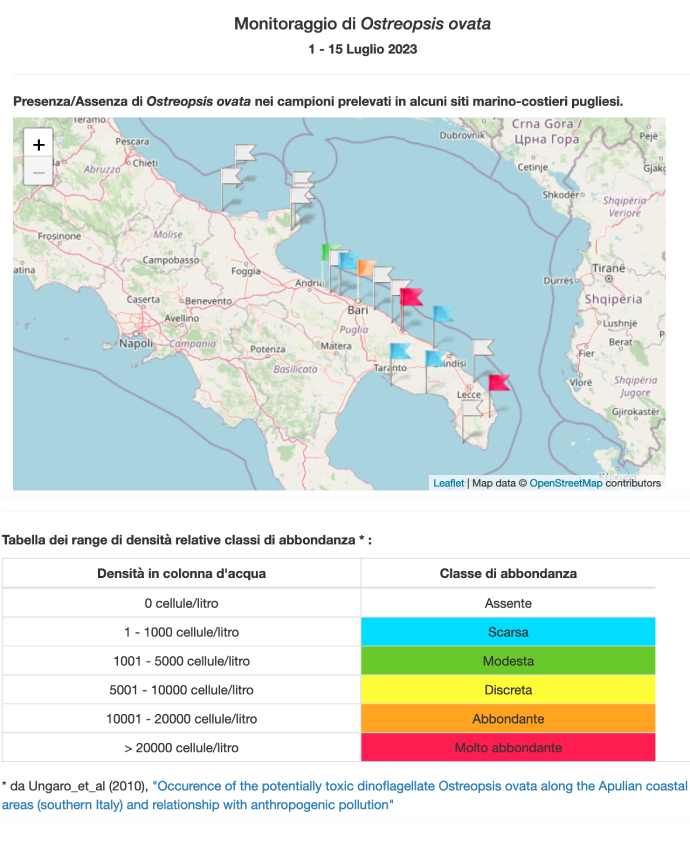 With the increase in temperatures, the so-called toxic algae returns to Puglia in some coastal areas. Arpa Puglia , we recall, has active monitoring Ostreopsis ovata (this is the name of the microorganism invisible to the naked eye because it is microscopic ) for the summer season, with the aim of verifying, in some coastal stretches intended for bathing, the qualitative and quantitative presence of mentioned microalgae, potentially toxic.
With the increase in temperatures, the so-called toxic algae returns to Puglia in some coastal areas. Arpa Puglia , we recall, has active monitoring Ostreopsis ovata (this is the name of the microorganism invisible to the naked eye because it is microscopic ) for the summer season, with the aim of verifying, in some coastal stretches intended for bathing, the qualitative and quantitative presence of mentioned microalgae, potentially toxic.
From June to September, the Agency constantly monitors – with a fortnightly frequency (increased in the case of overt flowering) – 20 sites, distributed throughout the region and representative of the coastal typology potentially affected by the presence of the species. While the coasts of the Foggia area , the Province of Barletta-Andria-Trani and Taranto are currently free from the excess of the phenomenon , in a locality in the Bari area – the ” Lido Trullo ” area there is an ” abundant ” presence, while in the ” Torre canne, in front of the lighthouse ” – in the province of Brindisi – a presence is reported“very abundant ” of toxic algae. The same assignment also for Porto Badisco-port of Enea in Otranto (in the province of Lecce ). We remind you that the presence of toxic algae is linked to the increase in temperatures and therefore the next ARPA measurements could vary. A screenshot of the interactive map with its legend:

The complete report in .pdf: https://www.arpa.puglia.it/moduli/output_immagine.php?id=7661
How it arrived on the Apulian coast and how it adapted:
Probably accidentally introduced into the Mediterranean through the ballast water of ships, the first reports along the Apulian coasts occurred starting from the year 2000/2001.
The population grows abundantly during the summer months.
The environmental factors that facilitate the proliferation are: high temperatures, high atmospheric pressure, favorable irradiation conditions, calm sea for a period of time exceeding 10-15 days.
Potential effects on the environment and public health:
A toxin (Palytoxin similar) has been identified in the species; there have been deaths and/or suffering of marine organisms (starfish, sea urchins, crabs, cephalopod molluscs, etc.) in conjunction with high concentrations of Ostreopsis in the waters and on the seabed.
Furthermore, cases of transitory malaise have been found in bathers (rhinitis, pharyngitis, laryngitis, bronchitis, fever, dermatitis, conjunctivitis) in conjunction with high concentrations of Ostreopsis in the waters and on the seabed, and especially after storm surges (storm surges favor the formation of aerosols marine, which can spread the toxin in the air).
How to avoid any harmful effects of Ostreopsis:
- in the case of certified Ostreopsis flowering , avoid standing along rocky coasts during storm surges;
- in the case of certified Ostreopsis flowering , limit the consumption for food purposes of organisms such as, for example, sea urchins. In fact, sea urchins, due to their eco-biology (they graze on algae) could potentially accumulate the toxin
Source: https://www.arpa.puglia.it/pagina2891_alga-tossica-ostreopsis-ovata.html
Regarding the PugliaReporter.com blog , we remind you that it is possible to receive all the news in real time from Telegram by registering at the following address > https://t.me/pugliareporter < from Instagram at the following address > instagram.com/puglia_reporter < as well as from Facebook by clicking ” like ” on Facebook.com/PugliaReporter and from Twitter at the following address > twitter.com/pugliareporter < . Also through Telegram it is also possible to send us reports in real time also withvideos and photos . It is also possible to write to us via Whatsapp to send us reports also with photos and videos by clicking here and subscribe to the Whatsapp group to receive our links by clicking here .



